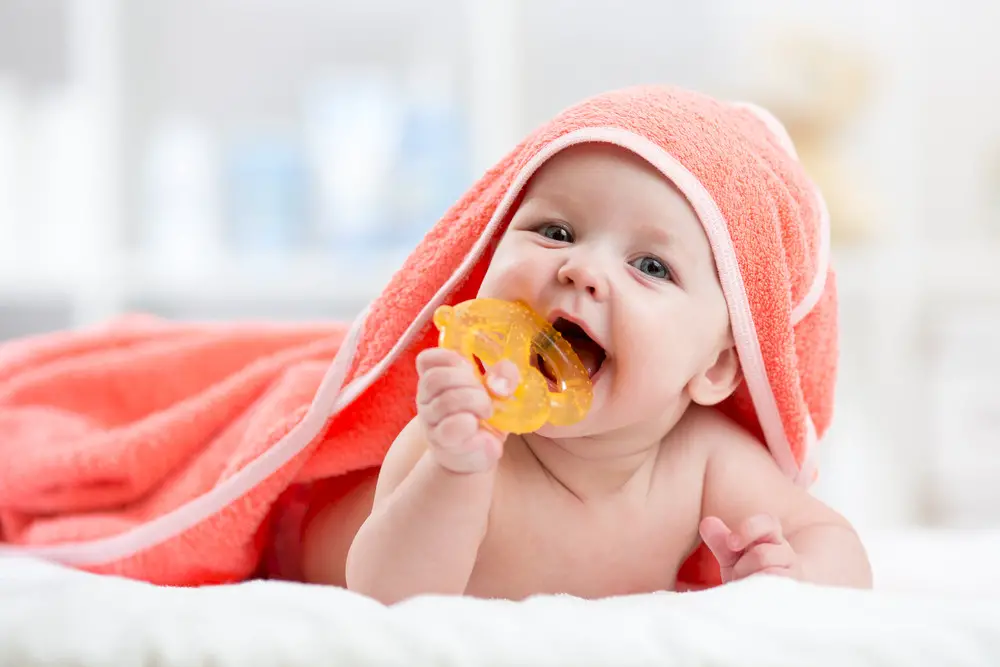When your baby begins the process of teething, it can be difficult for both you and your baby. The symptoms of teething can be stressful for babies and parents, as it is often misunderstood how to help relieve pain due to teething.
While the average age for a baby to begin teething and getting their first tooth is around six months old, babies can get their first teeth as early as three months old and as late as one year old.
To recognize the signs of teething in babies and understand how to help relieve teething pain, it is essential to know as much as possible about when do babies start getting their teeth.
When Do Babies Start Getting Teeth?
Your baby’s first teeth usually come in when they are about six months old. However, some babies are born with their first teeth. Some babies begin getting their teeth around four months old, while others take longer, getting their first teeth around one year old.
What Teeth Do Babies Get First?
As a parent, you likely wonder when do babies start to get teeth as you want to prepare for teething.
The bottom incisors are the first teeth to come in, located in the bottom front. The incisors first come through typically when babies are between five and seven months of age. The next teeth to come in are the top incisors in the mouth’s top front.
They enter when babies are between six and eight months old. The top lateral incisors come through. The top lateral incisors are the teeth located on either side of the top front teeth. They will appear between nine and eleven months of age.

What Are The Signs of Teething in Babies?
The signs of teething can be different for every baby, but generally, they include the following symptoms:
- A slight fever, but less than 101 degrees Fahrenheit
- Coughing
- Tender and swollen gums
- Putting their hands near their mouth
- Changes in sleeping or eating patterns
- Crying and fussiness
- Trying to chew or gnaw on hard items
- Excessive drool
- Rubbing their cheeks
- Restlessness
- Reduced interest in solid foods
- Sensitive or swollen gums
- Pulling their ears
- Irritability
- Increased sucking
These are the most typical signs of teething in babies. However, babies can develop other symptoms of teething that are not as usual. These symptoms include vomiting, rashes, diarrhea, a high fever, or congestion and are signs that should be discussed with your child’s pediatrician as soon as possible.
In addition, you should call your pediatric dentist if your baby has facial swelling, bleeding gums, or swelling.
How Long Does Teething Pain Last For?
Babies will experience the pain from teething when they get their new tooth to a few days after it cuts through their gums.
Generally, the pain from a new tooth erupting will last for about a week per new tooth. While a week may not sound like a long time, it can be incredibly long for your baby if they get multiple new teeth at once.
What Do Gums Look Like When Teething?
When babies experience teething, their gums often become swollen, red, or appear to be bulging. They may also have flushed cheeks or a facial rash due to the irritation. You can tell a new tooth is coming in by examining its gums.
After washing your hands, gently touch your baby’s gums to see if you can feel a tooth growing underneath. If you see a blister, you should avoid touching it. Blisters are typical and will go away without treatment. A new tooth underneath the gums appears pink and bulging.
When it breaks through, the baby will have a small white portion of the tooth showing through the gums.
How Many Teeth Should a 1-Year-Old Have?
Most one-year-olds have two to four teeth, but that number can vary depending on the baby. Some one-year-olds might have one or two teeth, while others may have multiple teeth. The delay of tooth eruption in babies can be due to genetics, as it tends to run in the family.
How Many Teeth Should a 3-Year-Old Have?
When a child reaches three years old, they should have about 20 primary teeth. A three-year-old child will have their central incisors, lateral incisors, canines, first molars, and second molars. The central incisors are the front teeth that help bite food and break it into chewable pieces.
The lateral incisors are the teeth between the two front teeth and the canines. They also are responsible for helping chew food. The canines are the pointy and sharp teeth on the top and bottom, which are responsible for tearing and gripping food to chew.
The first molars and second molars have flat surfaces and are rectangular teeth in the back of the mouth. They are used to help grind food.
Does Teething Pain Stop Once the Tooth Cuts?
Yes, the teething pain stops once the tooth cuts through the gums. Babies experience pain while the tooth is trying to break through the gums. Once it cuts, there is no more pain. To help relieve pain from teething, there are some things you can do.
- Gently massage or rub the gums with clean fingers
- Allow the baby to suck on or chew a firm rubber teether (you can refrigerate the teether)
- Introduce some hard foods, such as a peeled and chilled cucumber or carrot
- Gently rub their gums with a cool washcloth
- Try an over-the-counter remedy, such as acetaminophen or ibuprofen, to help relieve pain
- Dry the drool to prevent skin irritation


Leave a Reply